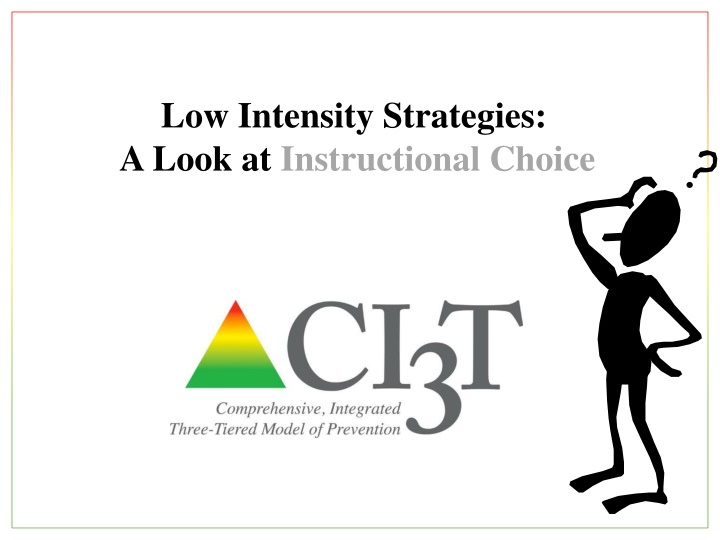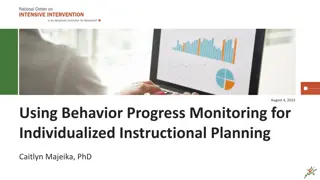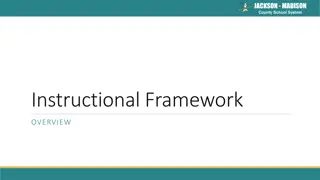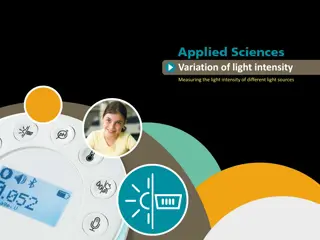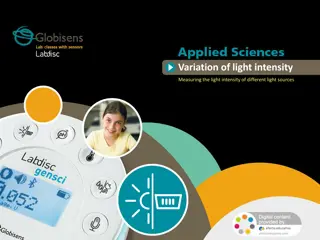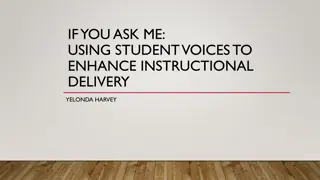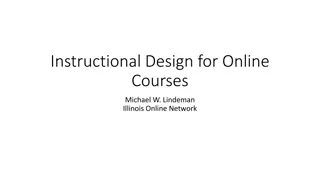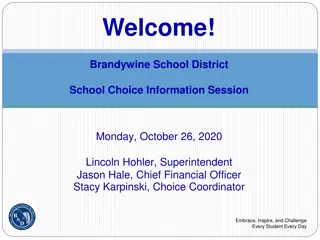Low Intensity Strategies: A Look at Instructional Choice
This content delves into the concept of instructional choice, providing insights on what it entails, its effectiveness, supporting research, benefits, challenges, implementation strategies, and impact assessment. It also explores a comprehensive model of prevention and the application of instructional choice in educational settings.
Download Presentation

Please find below an Image/Link to download the presentation.
The content on the website is provided AS IS for your information and personal use only. It may not be sold, licensed, or shared on other websites without obtaining consent from the author.If you encounter any issues during the download, it is possible that the publisher has removed the file from their server.
You are allowed to download the files provided on this website for personal or commercial use, subject to the condition that they are used lawfully. All files are the property of their respective owners.
The content on the website is provided AS IS for your information and personal use only. It may not be sold, licensed, or shared on other websites without obtaining consent from the author.
E N D
Presentation Transcript
Low Intensity Strategies: A Look at Instructional Choice
Agenda Comprehensive, Integrated, Three-Tiered (CI3T) Models of Prevention A Look at Instructional Choice What is instructional choice? Why is instructional choice effective? What does the supporting research for instructional choice say? What are the benefits and challenges? How do I implement instructional choice in my classroom? Implementation Checklist How well is it working? Examining the Effects
Comprehensive, Integrated, Three-Tiered Model of Prevention (Lane, Kalberg, & Menzies, 2009) Goal: Reduce Harm Specialized Individual Systems for Students with High-Risk 5% Tertiary Prevention (Tier 3) Goal: Reverse Harm Specialized Group Systems for Students At-Risk 15% Secondary Prevention (Tier 2) Goal: Prevent Harm School/Classroom-Wide Systems for All Students, Staff, & Settings PBIS Framework 80% Validated Curricula Primary Prevention (Tier 1) Academic Behavioral Social
Schoolwide Positive Behavior Support Comprehensive, Integrative, Three-tiered (CI3T) Models of Support Low Intensity Strategies Basic Classroom Management Effective Instruction Low Intensity Strategies Behavior Contracts Self-Monitoring - - Functional Assessment-Based Interventions Higher Intensity Strategies Assess, Design, Implement, and Evaluate Assessment
What is instructional choice? Instructional Choice opportunities to make choices means that the student is provided with two or more options, is allowed to independently select an option, and is provided with the selected option" (Jolivette, Stichter, & McCormick, 2002, p. 28). Types of instructional choices (Rispoli et al., 2013) Across-activity choices Within-activity choices
Examples of instructional choice Across-activities Choices Paper, presentation, or YouTube video to show me what you know? Which activity would you like to do first? Pick a learning center? Make your schedule for the day. Think-Tac-Toe Boards Within-activity Choices Crayons or sparkly markers? At your desk or in the library? In the reading corner or at your desk? Work independently or with a partner? Which book would you like to read? Finish in class or at home? Typed or handwritten? Even or odds?
Why is instructional choice effective? Easy Little time Offers students control Promotes decision making and other self-determined behaviors
What does the supporting research for instructional choice say? Increasing Engagement and Decreasing Disruption in Elementary Self-Contained Classrooms (Dunlap et al., 1994) Increasing Time On-Task, Task Completion, and Accuracy in Residential Facilities (Ramsey, Jolivette, Patterson,& Kennedy, 2010) Increasing Task Engagement and Improving Academic Performance in an Inclusive Setting (Skerbetz & Kostweicz, 2013)
Supporting Research See Instructional Choice Resource Guide for additional supporting research and information.
What are the benefits & challenges? Benefits feasible, does not require excessive preparation, is easy to implement, and supports content instruction (Kern & State, 2008; Morgan, 2006; Ramsey et al., 2010). teaches self-determined behaviors Challenges challenges in preparing independent tasks for the time provided important to think about procedures for collecting and evaluating different types of assignments
How do I implement instructional choice in my classroom? Implementation Checklist ! Determine which type of choices you feel comfortable offering and create a menu of choices. Step 1 Use the menu to determine which type of choice to add to a particular lesson. Step 2 After choice is built into the lesson, offer the established choices. Step 3 Step 4 Ask the student to make his or her choice.
How do I implement instructional choice in my classroom? Implementation Checklist Provide wait time for the student to select their choice. Step 5 Step 6 Listen to (or observe) the student s response Prompt the student to make a choice from one of the available options if the student has not made a choice within the time allotted. Step 7 Reinforce the student s choice, providing them with the option they selected. Step 8
How do I implement instructional choice in my classroom? Implementation Checklist Offer students an opportunity to give feedback on the choice they selected. Step 9
How do I implement instructional choice in my classroom? Step 1: Determine which type of choices you would feel comfortable offering to students in your classroom and create a menu of choices. Consider within activity or across activity choices. Step 2: Use the menu to determine which type of choices to add to a particular lesson. Step 3: After choice is built into the lesson, offer the established choices Step 4: Ask the student to make his or her choice. See Instructional Choice Implementation Checklist
How do I implement instructional choice in my classroom? Step 5: Provide wait time for the student to select their choice. Step 6: Listen to (or observe) the student s response. Step 7: Prompt the student to make a choice from one of the available options if the student has not made a choice within the time allotted. Step 8: Reinforce the student s choice, providing them with the option they selected. Step 9: Offer students an opportunity to give feedback on the choice they selected.
How well is it working? Examining the Effects Experimental Design Treatment Integrity Social Validity Is it What do stakeholders think about the goals, procedures, How well did this support work for happening? this and student? outcomes?
Making Certain the Strategy is in Place: Treatment Integrity Have structures in place to monitor whether instructional choice is carried out as intended: Treatment integrity checklist Example items: 1. I offered _______ the established choices. 2. I asked _______ to make their choice. 3. I provided ______ wait time to select their choice. 4. I listened or observed _______ s response. 5. I prompted _______ to make a choice from one of the available options if they had not made a choice within the time allotted. 6. I praised _______ s choice and provided them with the option selected. See Instructional Choice Treatment Integrity Checklist
What does the student think about it? See Instructional Choice Social Validity Student Completed by the student participating in the intervention at two time points: Pre and Post Intervention
What does the teacher think about it? See Social Validity Adapted- IRP15 Adult Completed by the teacher and/or parent participating in the intervention at two time points: Pre and post intervention
Sample Primary Intervention Grid Support Description Schoolwide Data: Entry Criteria Data to Monitor Progress Exit Criteria Instructional Choice Within- and across-task choices offered during instruction (e.g., language arts assignments, math lessons, etc.) One or more of the following: Behavior: SRSS-E7 Score: Moderate (4-8) SRSS-I5 Score: Moderate (2-3) Student Performance - Academic engaged time - Percentage of work completed Progress Reports: Five consecutive weeks of daily academic engagement 80% or better and work completion at 90% or better. Treatment Integrity - Implementation & TI checklist ___ AND ___ OR Academic: Progress Reports; Successful Learning Behaviors - Targeted for growth Gradebook: 2+ incomplete assignments Social Validity - Student & teacher pre/post survey (Lane, Menzies, Ennis, & Oakes, 2015)
Will you please Let s talk Continue to plan your instructional choice intervention.
Related Resources Lane, K. L., Menzies, H. M., Ennis, R. P., & Oakes, W. P. (2015). Supporting behavior for school success: A step- by-step guide to key strategies. New York, NY: Guilford Press.
